Unprecedented Fires in Patagonia
Air Date: Week of January 28, 2022
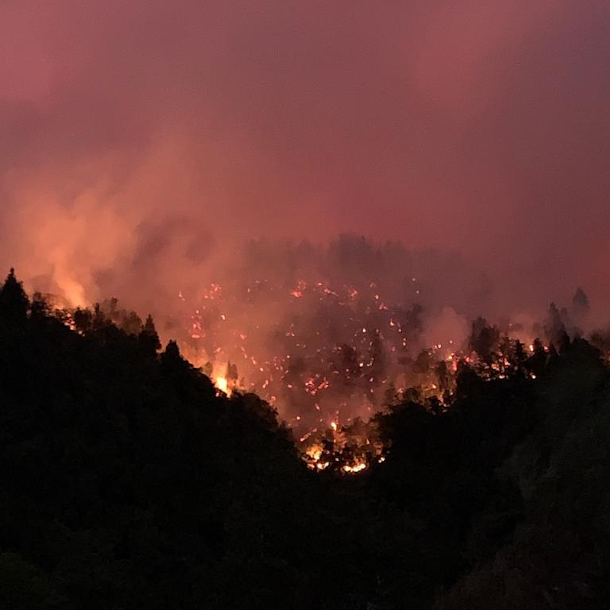
Until recently, wildfires only occurred every 500 years or so in Patagonia’s wet forests. Increasing heat, drought, dry lightning, and pine trees originally imported from North America are changing fire regimes and the local ecology. (Photo: courtesy of Thomas Kitzberger)
Out of control wildfires have been raging in Patagonia on the tip of South America, where until recently fires were rare. Butimported North American species, heat, drought, and dry thunderstorms connected to climate change are altering the natural fire regime. Thomas Kitzberger, a Professor of Ecology at the National University of Comahue in Argentina, joins Host Bobby Bascomb to discuss how fire is changing Patagonia’s ecosystems.
Transcript
CURWOOD: From PRX and the Jennifer and Ted Stanley studios at the University of Massachusetts Boston. This is Living on Earth, I’m Steve Curwood.
BASCOMB: And I’m Bobby Bascomb.
Out of control wildfires are raging in Patagonia, on the tip of South America in both Argentina and Chile. It’s been blazing hot during their summer, with the central part of Argentina reaching a record high of 113 degrees Fahrenheit in mid-January. And on January 12, Argentina’s federal government declared a one-year fire “emergency” because of the ongoing situation. Though the native vegetation for much of the region is a wet forest, major forest fires have become much more frequent in recent decades as the climate changes. Thomas Kitzberger is a Professor of Ecology at the National University of Comahue in Bariloche Argentina. That’s in the foothills of the Andes not far from the recent forest fires, and he joins me now to discuss. Welcome to Living on Earth, Thomas!
KITZBERGER: Thank you for inviting me.
BASCOMB: So can you please describe this region of Patagonia for our listeners who maybe haven't been there?
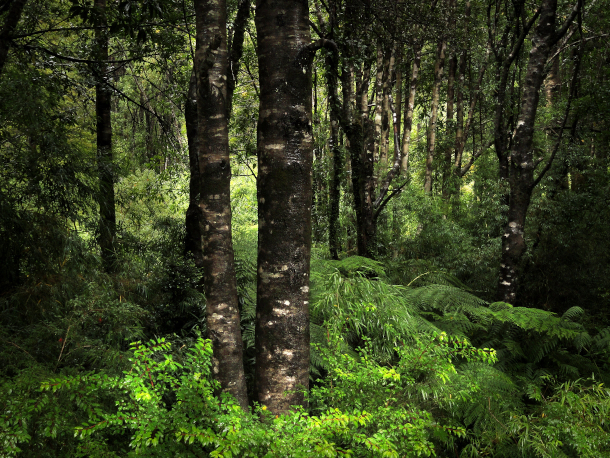
The Valdivian temperate rain forest ecoregion extends along western Patagonia from roughly 37° to 48° South latitude in both Chile and Argentina. (Photo: Mari L. Peña, Flickr CC BY-NC-ND 2.0)
KITZBERGER: Well, we are in a, in a forested region. These are southern temperate forests. These are evergreen trees, very different from the North American coniferous forest, that strive along the Andes, on both sides, from Chile and in Argentina. And they are basically fed by the rains that come from the Pacific Ocean, generating different kinds of forest like rainforest, Southern conifer forests, shrub lands, and finally the Patagonian Steppe, which is a grassland. There is an important rain shadow effect of the Andes, on this Pacific moisture that comes in, it’s just very similar to what happens maybe in Washington State, where you have the Cascades and the rain shadow, it's very similar. So it's like a, like a mirror of the Northern Hemisphere, but with very different species, species that are not really very adapted to fire. So, it is a, it is a fascinating region of the world.
BASCOMB: Well, it sounds just stunning, it sounds amazingly beautiful. But what has it been like there recently in terms of heat and fires?
KITZBERGER: Yeah, we are witnessing now very strong changes due to climate change. We are witnessing a 50-year-long trend in drying and in warming; we are experiencing hot spells. We are experiencing thunderstorms, which were not very common in this region in the past; mortality of forests, even without fire, trees die off due to drought. And of course, very large fires in recent times. So we are very concerned about those changes.

Planes from the Bariloche firefighting brigade fighting a forest fire near Lake Nahuel Huapi on January 3, 2015. (Photo: Mariano Srur, Flickr CC BY-NC-ND 2.0)
BASCOMB: How natural is fire in this region of Patagonia? What do you see in, you know, the longer history?
KITZBERGER: Well, the long history tells us that the fire was a disturbance in the forest, but it was not a frequent disturbance in the forest. So there could be eventual lightnings, there could be eventual volcanic eruptions, we have a lot of volcanoes here. And there could be also Indigenous people burning the forest. But these forest fires were generally smaller, and less frequent. So if you go back in time, and you reconstruct fire history of, of the wet forest, you could have fires every maybe 500 years. And this is completely compatible with the existence of these kinds of forests, these kinds of species that are not very well adapted to fire. But still, if the fire is not very frequent, very large trees, you know, a mature forest can withstand fire because the trees are very large. And some of the trees survive the fire and they create a new generation of trees that can strive until the next fire every 300, 400, 500 years. The problem is that under new climatic scenarios, the forest will burn more frequently, if the ignition is there. And the ignition is there now, you know, because there are more people and there are more lightnings.

Lake Nahuel Huapi is the largest of many lakes in Argentina’s Nahuel Huapi National Park, which surrounds the city of San Carlos de Bariloche. Forest fires have been burning in the park and the region during the 2021-2022 summer season in Patagonia. (Photo: David, Flickr CC BY 2.0)
BASCOMB: So tell me more about that. Why is there more lightning now in Patagonia, what's going on with climate change that's contributing to just the right conditions for more fire?
KITZBERGER: Well, this is something we have detected in the past 10 years, we have first looked at the number of lightning-ignited fires that were reported in historical documents. And we have noticed that since the 1980s, 1990s, the number of lightning-ignited fires that were reported has tripled compared to the previous period from the 1950s to the 1970s, which is correlated with increases in temperature of the summer. So we have, we're having hotter summers, drier summers, and summers that are more prone to thunderstorms. And these thunderstorms are related to a change in the circulation of the subtropical air masses that come from the Amazon and from Northern Argentina, from Paraguay. And they are funneled in from the north to the plains of the Andes, as far south as Bariloche and even farther south. I think that previously this climatic pattern was not very common because in general what we have is westerly circulation of wind, and the westerly wind is generally very stable and does not produce lightning. So when you have a Pacific storm coming in, it doesn't carry lightning. Whereas when you have a northerly wind coming in, it is very unstable air. So and this produces generally these dry thunderstorms which are so dangerous in our region because they don't produce much rain, but they produce lightning. And if that combines with a drought, the probability of ignition of a lightning, that it ignites a fire, is very high.
BASCOMB: Yeah, seems like a very good scenario for creating fire. And I understand that there is a monoculture of pine trees that were planted there decades ago for timber. How do they factor into the fires that you're experiencing?
KITZBERGER: Yeah, it's not a very good combination, because these plantations were promoted by the Argentinian government during the 1970s and 1980s. And they were promoted by subsidies. So the owners of the land were given money to plant pine trees. Ponderosa pine; Radiata -- Pinus radiata; Pseudotsuga -- Douglas fir; Lodgepole pine; all these trees that are northern hemisphere conifers, generally from North America. And you already know these are very flammable species, they have high content of resins, of volatiles in the leaves, they burn at very high intensities. So these species were planted for many, many years in Patagonia. And many of these plantations were later abandoned, unfortunately. They were abandoned because -- this is bad policy. There was not really a market for this wood, the wood was not very high quality. So the plantations were abandoned because the money was already cashed in. The government paid for the seedlings, they didn't pay for the, for the mature trees. So once the plantation was established, the plantation was not taken care of. There was no thinning. So these trees are loaded with dry fuels. And the other problem is that some of these species are very invasive to our native ecosystems. So what has happened during the last three to four decades, is an active invasion of conifer trees into native ecosystems. And these trees are capable of establishing under the canopy of the native trees. And they create what we call novel ecosystems. These are novel combinations of native trees with conifer trees. And the problem is, when a fire sweeps through that invaded native ecosystem, the dominant tree after the fire sweeps through the forest will be the exotic conifer.
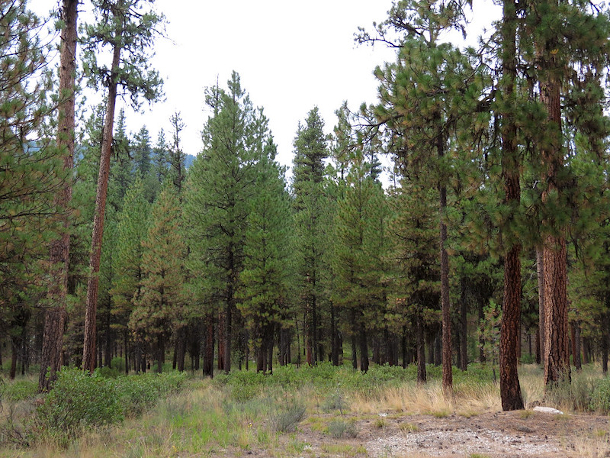
Ponderosa, lodgepole, and radiata pines are among the fire-adapted North American species that have been invading Patagonian forests and creating what ecologists call novel ecosystems. (Photo: Katja Schulz, Flickr CC BY 2.0)
BASCOMB: You know, I've read personal accounts of people that that survived the fires there, and they say these massive pine trees just went up -- [SNAPS FINGERS] you know, like that, just in minutes, they were just in flames and practically gone, you know, immediately, it was just; they burn so quickly.
KITZBERGER: Yeah, they have adapted for millions of years to burn very hot, the conifers. But they, at the same time, they have created their own adaptations to, to repopulate the area afterwards. So the serotinous cones, which open with the heat, and many other adaptations like very thick barks to resist the fire, and so on. And some of the fire policies that are being applied in Patagonia come from the fire science ecology school of North America. And the problem is that you cannot translate, really, the policy of fire of North America to Patagonia, because the species behave very differently. For instance, in North America, the more time you, you wait to a forest to mature, the more flammable the forest will be. And this has created the idea of prescribed burning to reduce the flammability of the forest. Here in Patagonia, it's absolutely the reverse. When you burn a forest, you create a shrubland, and the shrubland is more flammable than the forest. So prescribed burning would create the, the opposite effect here in our forests than in a coniferous forest.
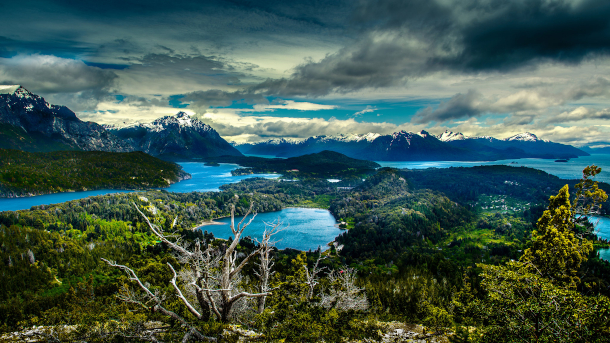
The view from mountain Cerro Campanario in Nahuel Huapi National Park, where fires have been burning during the 2021-2022 summer season in Patagonia. (Alexander Shchukin, Flickr CC BY-NC-ND 2.0)
BASCOMB: Professor Kitzberger, to what extent is Patagonia experiencing a new normal in climate? What do climate scientists tell us we should be expecting in that region in the coming decades?
KITZBERGER: We are already in a new normal, and the global change models all agree that the region will experience at least a reduction in 20 to 30% in rainfall. And this is not for the most pessimistic scenarios, but for a very probable emission scenarios; and an increase in temperatures of two to three degrees Celsius. And our fire probabilities, or frequency, could increase two to three fold during the mid twenty-first century and six to eight fold during the late twenty-first century, which is really disastrous for our ecosystems.
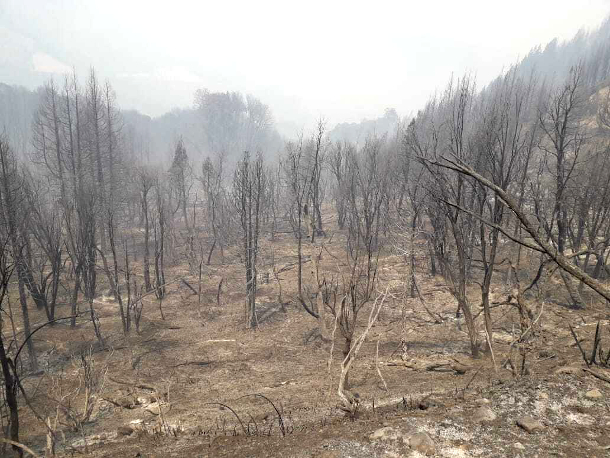
A Patagonian forest after a fire has swept through (Photo: Javier Grosfeld)
BASCOMB: How does it feel for you as a scientist to be living there and documenting these changes and at the same time, see so little action, you know, to get to the root cause of things?
KITZBERGER: I started studying fire in this region 35 years ago. I was very young. And the first [LAUGHS] reaction of people, when I was saying I was studying fire in this region is, "Why are you studying fire? There is no fire in this region." And the perception of fire is very dependent on the events. I don't know if that happens in North America too. But during years of very little fire, people lose interest in fire. But then a very big fire year happens and everybody's very worried. But then they lose interest very quickly. That has been my, my impression for many, many years. And the changes in society are very slow, I would say, but they are still there. I think young people, when I talk to very young people, they are very aware now that this is a problem that has an underlying problem of climate change. And the actions that we have to do occur at very different levels, from the individual actions to the government actions. So Argentina is very, very slow also in complying with international treaties on emissions, like many other countries in the world, they are very slow --
BASCOMB: I was gonna say, it's not just Argentina! [LAUGHS]
KITZBERGER: [LAUGHS] So yeah, my general feeling, to answer your question is a little bit of frustration with the politicians. But with a lot of hope of the new generations, of young people.
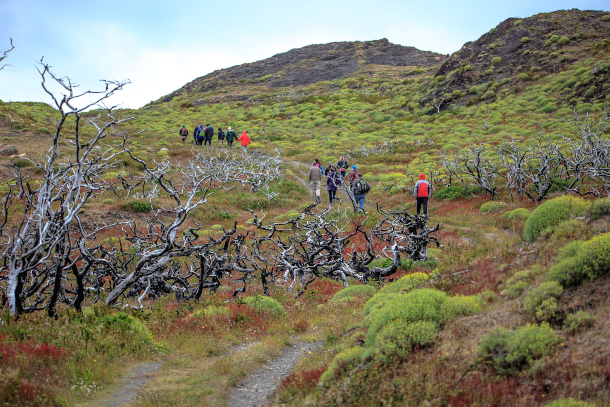
A photo taken in Torres del Paine National Park, which is part of Chilean Patagonia, shows a burned-out forest transitioning to shrubland. (Photo: Murray Foubister, Wikimedia Commons)
BASCOMB: I bet you hope that you had been wrong in your choice of career, you know, if you go back 35 years, and say oh, I should have gone into something else. There's no fire here. They were right! [LAUGHS]
KITZBERGER: [LAUGHS] Well, when I started biology, I am a biologist as an undergrad, I was going to be a marine biologist. But I guess, in marine biology, very similar things occur too, to the marine biologists. They are now worried, very worried about plastics, they're worried about warming, they are worried about acidification. So everywhere you look at there are problems.
BASCOMB: With such a dramatic increase in the fires there in Patagonia already, what solutions might there be to prevent these fires, to make the native forests more resilient, or, you know, to ameliorate the situation?
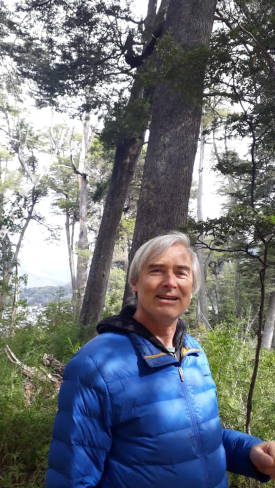
Thomas Kitzberger is a Professor of Ecology at the National University of Comahue in Bariloche, Argentina (Photo: courtesy of Thomas Kitzberger)
KITZBERGER: Yeah, there are many aspects that we can work on. After the fire, we can work on restoration, not necessarily to go back to the original condition, but to go into a new landscape that maybe is more resilient to the next fire. So we are thinking of things like reforesting, or doing restoration with species that are less flammable, that are more resilient to fire -- native species, I mean. So our species that are more adapted to warmer conditions. So we really have to assume that the conditions of the future are going to be different. We cannot have the romantic idea of going back to our nineteenth century landscape because it's, it's a romantic view, which is not going to be very resilient to the future conditions.
BASCOMB: Thomas Kitzberger is a Professor of Ecology at the National University of Comahue in Bariloche, Argentina. Thank you so much for taking this time with me today. I really enjoyed our chat.
KITZBERGER: Oh, it was a pleasure. Lovely. Thank you very much for inviting me.
Links
National Geographic | “An imported tree fuels Patagonia’s terrifying summer fires”
Latin American Post | “Valdivian forest: a biogeographic island that was saved from the glaciations”
Living on Earth wants to hear from you!
Living on Earth
62 Calef Highway, Suite 212
Lee, NH 03861
Telephone: 617-287-4121
E-mail: comments@loe.org
Newsletter [Click here]
Donate to Living on Earth!
Living on Earth is an independent media program and relies entirely on contributions from listeners and institutions supporting public service. Please donate now to preserve an independent environmental voice.
NewsletterLiving on Earth offers a weekly delivery of the show's rundown to your mailbox. Sign up for our newsletter today!
 Sailors For The Sea: Be the change you want to sea.
Sailors For The Sea: Be the change you want to sea.
 The Grantham Foundation for the Protection of the Environment: Committed to protecting and improving the health of the global environment.
The Grantham Foundation for the Protection of the Environment: Committed to protecting and improving the health of the global environment.
 Contribute to Living on Earth and receive, as our gift to you, an archival print of one of Mark Seth Lender's extraordinary wildlife photographs. Follow the link to see Mark's current collection of photographs.
Contribute to Living on Earth and receive, as our gift to you, an archival print of one of Mark Seth Lender's extraordinary wildlife photographs. Follow the link to see Mark's current collection of photographs.
 Buy a signed copy of Mark Seth Lender's book Smeagull the Seagull & support Living on Earth
Buy a signed copy of Mark Seth Lender's book Smeagull the Seagull & support Living on Earth

